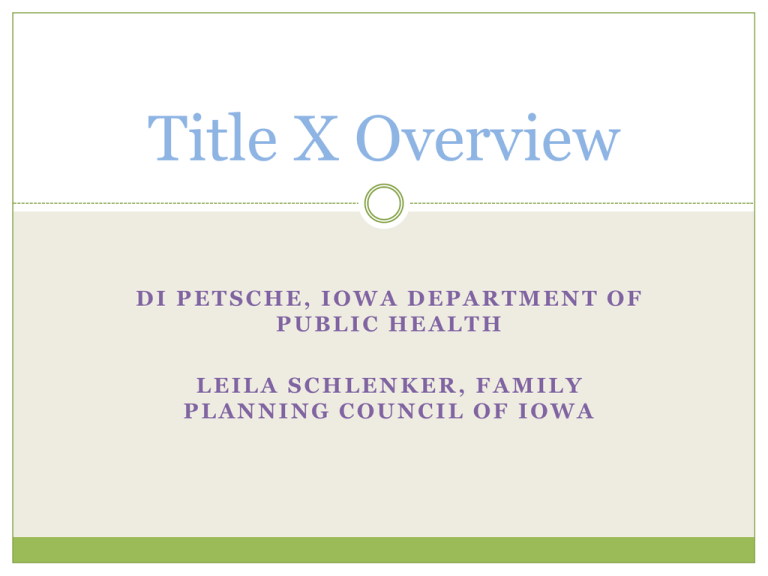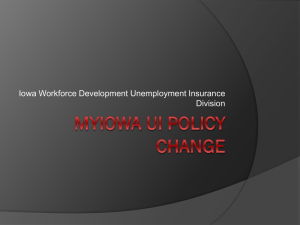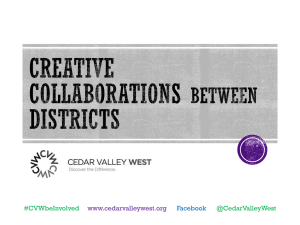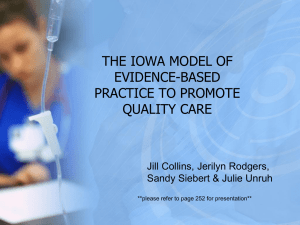
Title X Overview
DI PETSCHE, IOWA DEPARTMENT OF
PUBLIC HEALTH
LEILA SCHLENKER, FAMILY
PLANNING COUNCIL OF IOWA
OBJECTIVES
1. Identify the funding source of the
federal family planning program
2. Explain 3 requirements of Title X
3. Identify some terminology unique to
Title X
What is Title X?
• Created in 1970 as part of the Public
Health Services Act.
• The only federal program dedicated to
family planning and reproductive health
care.
• Mission: To provide individuals with
information as a means to exercise
personal choice in determining the number
and spacing of their children.
US Department of Health and Human Services
Office of Public Health & Sciences
Office of Population Affairs
Office of Family Planning
FPCI
DHHS Region VII Office (Kansas
City)
IA, KS, MO, NE
Central Iowa Family Planning
Edgerton Women’s Health Center
Hillcrest Family Services
Planned Parenthood of the
Heartland
Trinity Muscatine Public Health
Webster County Health
Department
Women’s Health Services
IDPH
Allen Women’s Health
New Opportunities
Crawford County Home Health
North Iowa Community Action
Northeast Iowa Community Action
Southern Iowa Family Planning
St. Luke’s Family Health Center
Title X Services in Iowa
FPCI’s Title X service area covers 55 of
Iowa’s 99 counties.
• IDPH Title X service area covers 45 of
Iowa’s 99 counties.
• Both grantees cover Polk County
•
Title X Clinic Sites - FPCI
Family Planning Council of Iowa
•
Central Iowa Family Planning
-- Marshalltown
-- Toledo
-- Grinnell
•
Edgerton Women’s Health Center
-- Davenport
•
Hillcrest Family Services
-- Dubuque
•
Planned Parenthood of the Heartland
-- Des Moines x 3
-- Ames
-- Burlington
-- Sioux City
•
-- Iowa City
-- Council Bluffs
-- Keokuk
Trinity Muscatine
-- Muscatine
•
Women’s Health Services
-- Clinton
•
-- Maquoketa
Webster County Health Department
-- Fort Dodge
--Webster City
--Humboldt
--Clarion
Title X Clinic Sites- IDPH
Iowa Department of Public Health
Allen Memorial Hospital
•
-- Waterloo
-- Independence
Crawford Co. Public Health
•
-- Denison
-- Atlantic
-- Harlan
-- Onawa
-- Logan
New Opportunities
•
-- Carroll
-- Des Moines
•
-- Ankeny (DMACC)
North Iowa Community Action
-- Mason City
-- Hampton
Title X Clinic Sites - IDPH
Iowa Department of Public Health
•
Northeast Iowa Community Action
-- Decorah
•
St. Luke’s Family Health Center
-- Cedar Rapids x 3 (Kirkwood)
-- Vinton
-- Mt Vernon x 2 (Cornell)
•
-- Anamosa
-- Monticello
Southern Iowa Family Planning
-- Ottumwa
-- Bloomfield
-- Sigourney
-- Oskaloosa
-- Keosauqua
-- Centerville
-- Fairfield
-- Chariton
-- Albia
-- Corydon
Impact of Title X
In 2012, Title X enabled women to avoid 1.1 million
unintended pregnancies, 48% (526,900) of which
would have likely resulted in unplanned births, and
36% (362,500) would have likely have ended in
termination.
Nationally, for every $1.00 spent to provide services in
publicly funded family planning clinics,
approximately $5.68 in Medicaid expenses on births
are averted (2010)
In Iowa, for every $1.00 spent to provide services in
publicly funded family planning clinics, $3.78 in
Medicaid expenses on births are averted (2009)
The National Picture
2012 Title X User
Characteristics*
92% female
19 % under age 20
51 % age 20 – 29
28 % Hispanic or Latino (all races)
20 % Black or African American
5 % More than one race
71 % < 100% of Federal Poverty Level
90 % < 200% of Federal Poverty Level
64 % uninsured
*2013 National Title X FPAR Report (2012 Summary)
Title X in Iowa 2012
Total Number Served
75,073
Total number of women served
62,941
Total number of men served
4,051
People served with incomes at or below
250% of FPL
54,337
Cervical Cancer Screenings
Abnormal findings
19%
STI Testing Performed
68,255
HIV Tests Performed
7,696
Title X Program Guidelines & Program
Instructions
Title X Program Guidelines for Project Grants for
Family Planning Services was developed by the Office
of Population Affairs (OPA), U.S. Department of Health &
Human Services (DHHS), to assist current and
prospective grantees in understanding and utilizing the
family planning services grants program authorized by
Title X of the Public Health Services Act, 42 U.S.C. 300, et
seq.
The Office of Population Affairs also provides more
detailed guidance, updated clinical information, and
clarification of specific program issues in the form of
periodic Program Instructions.
Title X Program Guidelines…Definitions
Grantee is the organization that receives a federal
grant and assumes legal and financial responsibility for
good stewardship of public funds.
Sub-Recipients or contractors receive grantee
funds, through formal agreements with the grantee,
and whose purpose is to carry out the project of direct
services to clients. Some have multiple service sites or
clinics to cover specific geographic areas.
"The project" refers to activities defined by the
grantee and supported by the budget described in the
grant application.
Title X Compliance Issues
As the Title X Grantees for Iowa, FPCI and IDPH
are responsible to the Federal government for
administering the program.
The Grantees:
assure that services are available for low-income
Iowans.
monitor sub-recipient performance by reviewing
monthly, quarterly, and annual reports.
conduct regular site reviews of sub-recipient
clinic sites and programs.
assure that funds are spent according to federal
guidelines and requirements.
Title X Services
A variety of birth control methods and supplies
Tests and treatment for sexually transmitted diseases
HIV/AIDs education and testing
Basic infertility services.
Breast and Cervical Cancer screening
Testicular Cancer screening
Pregnancy tests and options counseling
Health education on sexuality and related topics
Reproductive Life Planning
Title X Priorities*
1. Assuring the delivery of quality family planning and related
preventive health services
2. . Providing access to a broad range of acceptable and
effective family planning methods and related preventive
health services in accordance with Title X program
requirements and nationally recognized standards of care.
3. Assessing clients’ reproductive life plan as part of
determining the need for family planning services, and
providing preconception services as appropriate;
4. Addressing the comprehensive family planning and other
health needs of individuals, families, and communities
through outreach to hard-to-reach and/or vulnerable
populations.
5. Identifying specific strategies for adapting delivery of
family planning and reproductive health services to a
changing health care environment including addressing
provisions of the Affordable Care Act (ACA).
*found
on OPA website
Title X
Program
Requirements
• Introduction
• The Law,
Regulations and
Guidelines
• Application
Process
• Project
Management
• Client Services
• Required
Services
Program Guidance
(“QFP”)
• Introduction
• Title X Clinical
Requirements
• Service Delivery
and
Infrastructure
Building
• Client
Encounters
Legal Issues for Title X Participants
Voluntary Participation
Use of project services by an individual must be voluntary.
Coercion must not occur with clients receiving services or to use or
not use particular methods can be occurring within a project site.
Coercion of abortion or sterilization must not take place.
Confidentiality
Clients must be assured of confidentiality. All providers must be
HIPPA compliant.
Conflict of Interest
No personal gain may occur from working within a Title X program.
No funds may be used to support lobbying efforts.
Section 1007
The acceptance by any individual of family
planning services…shall be voluntary and
shall not be a prerequisite to eligibility for or
receipt of any other service…
Section 1008
Prohibition on Abortion
None of the funds shall be used in
programs where abortion is a method of
family planning
What does providing
confidential services mean?
Title X Grantees & Clinic Sites must comply
with Federal Requirements
Cannot deny services or subject any client to
any variation in services due to their inability
to pay.
Title X must be the last payer for services.
Must provide specific services to adolescents.
Title X Grantees & Sub-Recipients must comply
with Federal Requirements
Educational materials used for clients must
be reviewed and approved by an Information
& Education Committee. This committee of
5-9 members must be broadly representative
of the community.
Title X Grantees & Sub-Recipients must comply
with Federal Requirements
Must provide an opportunity for participation in the
development, implementation, and evaluation of the
project by persons broadly representative of all
significant elements of the population to be served.
You may use your I & E Committee, Board of
Directors, or establish an advisory or community
group for this purpose, however, the community
participation function {development, implementation
and evaluation of project} should be tracked and
documented separately from I & E activities.
Title X Grantees & Sub-Recipients must comply
with Federal Requirements
Providers of services must be qualified to
provide services.
Clinical and educational services are
prescribed by the program requirements.
All sub-recipients must comply with Federal
anti-trafficking laws, including the
Trafficking Victims Act of 2000. Subrecipients must have a written policy
regarding training staff on human trafficking.
Title X Clinic Fee Collections
Charges based on costs and placed on a sliding
fee scale
Request donations
Bill Medicaid
Bill private insurance
Clients charged based on sliding fee scale
Title X Client Eligibility
Income below 100% of poverty, free services
Income 101 – 250% of poverty, sliding scale
250% + of poverty, full fee
Income level of no-contact minors
determined on their income only (not
parents’ income)
Fiscal Requirements – Billing/Collections
Third party payers are billed at full fee. Clinic must be
reimbursed prior to billing the client any remaining amount
of client responsibility.
Reasonable efforts to collect without jeopardizing
confidentiality
Required Title X Services
Medical Services
Health Education
Community Participation,
Education and Outreach
Framework for Family Planning,
Related and Other Preventive Services
Other Preventive Health
Services
Related Preventive Health
Services
Family Planning Services
• Contraceptive services
• Pregnancy testing
• Achieving pregnancy
• Basic infertility services
• Preconception health
• STD Services
Family Planning Services
A constellation of services that include:
Contraceptive services
Pregnancy diagnosis & counseling
Achieving pregnancy
Basic infertility services
Preconception health
Prevent STIs
Key Title X Clinical Expectations
Project operates under a qualified medical director
Maintain written protocols for clinical care per national
standard, e.g., CDC, USPSTF, ACOG (per OPA Program
Instruction 09-01)
Services must be based on those protocols
Grantee responsible for ensuring pertinent clinical
protocols and services in its clinics
Compliance with state pharmacy regulations
Written plans for clinical emergency management
Appropriate CLIA laboratory certification
QA Process & Monitoring – ensure adequate
documentation of these activities
*All plans must be location specific – need to enlarge to above 18
Reproductive Life Planning
The RLP is a conversation about an individual’s
life goals, including reproductive goals, that
prompts both non-sexually active and sexually
active individuals to think of themselves in
relationship to their life and parenting goals.
The plan can be started at any age and can be
changed whenever the individual wants as
his/her life changes!
Opening the RLP Conversation
Where do you see yourself in the next 5 years? The next 10 years?
(Married? Single? In school? Working? Living in a home or apartment?
What about education?
How about a career or job you’d want to do?
Do you want to have children (or more children) or do you not want to
have children? (remember this answer may change with time)
What things do you think you can do now to help you achieve your
parenting goals some day (avoid STIs, eat a healthy diet, taking the right
vitamins, exercise, avoid alcohol, substance use and smoking, update your
vaccinations, learn your family history)?
Are there things you can do to get ready to have a healthy pregnancy when
you are ready (deal with emotional and physical well-being, manage
depression, abuse, and stress, avoid or quit smoking, fix your diet, take
the right vitamins, begin regular exercise, avoid alcohol and substance
abuse) ?
You do want to have children.
What questions will help you plan that?
If you are having sex or when you start having sex, do you have a
plan in place to prevent pregnancy until you are ready to have a
baby? Can we help you with that plan?
How many children do you want to have?
At what age do you want to have your first child, or your next
child?
Are you using a method of birth control? Are you happy with the
method? If not, are there other methods you would be interested
in talking about?
If you want to try to become pregnant soon, do you have any
health problems, family illness or birth defects or take any
medications that could affect you or your baby?
If you get pregnant before you are ready, what will you do? What
changes will happen in your life plans?
You don’t want to have children.
What questions will
help you plan that?
If you are having sex or when you start having
sex, do you have a plan in place to prevent
pregnancy? Do you know where to go for help
with that?
If you get pregnant before you are ready, what
will you do? What changes will happen in your
life plan?
Client Education Requirements
Help the client to:
Make informed decisions about family planning, including
specific methods of contraception and adverse effects.
Perform breast/ testicular self examination, if interested.
Reduce risk of transmission of sexually transmitted diseases and
HIV
Pregnancy Options
Understand the importance of recommended screening tests and
other procedures involved in the family planning visit.
All clients, regardless of age, should receive information about
sexual violence, reproductive coercion and human trafficking.
Client Counseling
The counseling process assists clients in reaching an
informed decisions about reproductive health.
Counseling refers to the dialogue that must cover all
aspects of informed consent.
Information for planned return, emergency 24 hour
phone numbers, location of emergency services and
appropriate referral for additional services.
Required Title X Clinical Services
Physical Assessment (according to QFP)
Fertility Regulation – temporary and
permanent
Basic Infertility Services
Pregnancy Diagnosis and Counseling
Adolescent Services
STI (including HIV) services
Additional services that might be offered by
Title X Clinics
(not part of or paid for by the Title X Program)
GYN services
Prenatal & postpartum care
Pregnancy termination
Care of the Adolescent Patient
Adolescent appointments must be made as soon as
possible.
Adolescents must be given age appropriate information.
Abstinence as well as contraceptives and safer sex
practices with options to reduce risks for STD/HIV and
pregnancy must be discussed with all adolescents.
Adolescents must be counseled about the availability of
confidential services.
Adolescents must be encouraged to include family
participation in their decision to seek family planning
services. (or to talk to a trusted adult)
Care of the Adolescent Patient
Title X projects may NOT require written consent of
parents or guardians for the provision of services to minors.
Parents or guardians may not be notified of services
obtained by the adolescent.
Counseling must be provided on resisting reproductive
coercion
Comply with state child abuse, sexual abuse, child
molestation, and incest reporting laws
A provision for the notification of a parent in the event that
a life threatening condition is identified must be included in
the consent for services. This provision is exercised only if
the minor is unwilling or unable to follow up on referrals.
Title X Clinics Must Provide FDA
Approved Contraceptive Methods
Eligible for participation in the Federal 340B
Program
• Federal Drug Pricing Bulletin Board
• Public Health Drug Pricing
• Drug Prices Lower than Medicaid Drug
Prices
Required Title X Reporting & Monitoring
As a Title X Grantees, IDPH and FPCI are
required to monitor, collect, analyze, and
report on all Title X services provided by subrecipients.
In addition to IDPH and FPCI reports,
sub-recipients must report on program activities
by completing the FPAR ( See Family Planning Annual
Report).
Additional monitoring and/or program reports
may be requested
Required Title X Reporting
Family Planning Annual Report (FPAR)
FPAR is Title X’s report on the services provided
Annual report based on the calendar year,
Submitted by grantees to the Office of Population Affairs
(OPA)
FPAR consists of 14 tables
Training
48
Purpose of Training
•
Improve and increase the delivery of Title X family
planning services to people, particularly low-income
groups, with a high percentage of unmet need for family
planning services
•
Improve family planning service delivery skills of family
planning personnel
National Training Centers
National Training Center for Coordination and Strategic
Initiatives (CAI and Altarum Institute)
National Training Center for Management and Systems
Improvement (JSI Denver)
National Training Center for Family Planning Service
Delivery (Cardea)
National Training Center for Quality Assurance, Quality
Improvement and Evaluation (JSI Boston)
Clinical Training Center for Family Planning (University of
Missouri, Kansas City)
Training Advisory Committee
Meets three times annually to develop
training for Title X staff
Training is based on clinic needs, a needs
assessment and on national priorities and key
issues
Training is sponsored by FPCI and IDPH
Technical Assistance
Focus on Clinic Efficiency and Sustainability
Work with Training Coordinator to complete
Request Form
For FPCI, all TA requests must be submitted by
January 31.
IDPH – as needed
Other topics related to running a Title X Clinic
Iowa Family Planning Network
The Iowa Family Planning Network (IFPN) is a
program that expands Medicaid coverage for
family planning services in Iowa. The Iowa
Department of Human Services (DHS) and the
family planning community worked together on
a request to the Center for Medicare and
Medicaid Services for waiving a section of the
Medicaid rules to allow expanded coverage to
more women in Iowa.
Iowa Family Planning Network
Expanded Medicaid coverage for family
planning services only
Covers both women and men
Individuals ages 12 – 54 with income below
300% of federal poverty guidelines
Covers individuals with private insurance that
does not pay for family planning services
Iowa Family Planning Network
Family planning clinic staff who process the
eligibility determination must be approved by
DHS
Eligibility may be processed at a family
planning clinic
Approved family planning clinic staff have
access to a national system to verify
citizenship (SVES)








